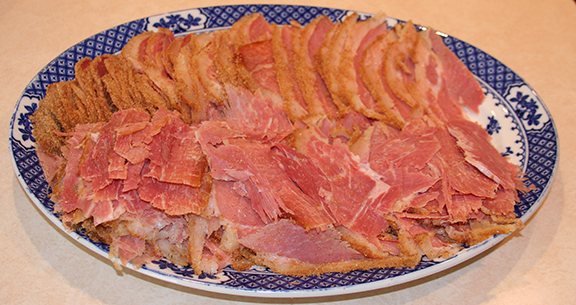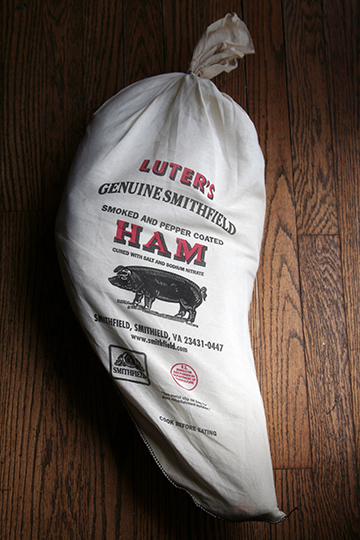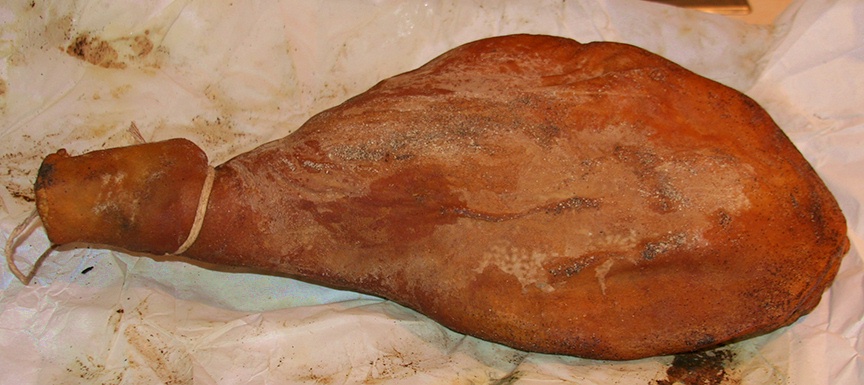Country Ham, and the undisputed King of this delicacy, Smithfield Ham, has been around since the first settlers at Jamestown. It was the early 90′s (That’s 1990′s, I’m not THAT old!) when I first cooked one of these. Leslie and I had moved to Capital Hill in Washington, DC, and would spend most Saturday mornings at Eastern Market, a neighborhood Farmer’s Market with all sorts of vendors. We went for Breakfast at the “Market Lunch,” sometimes standing in line for over an hour in order to eat Eggs Benedict, egg sandwiches on homemade rolls, and for me, Scrapple.
After breakfast we would waddle around the market, picking up fresh produce, sampling different cheeses, and gazing at all the wonderful things offered for sale. As Leslie headed off to the craft vendors, I would hit the Meat stalls. There were so many choices! Tons of different homemade sausages, ham hocks, steaks, ribs, pig’s feet (Which I have yet to try to cook), as well as other things that intrigued and disgusted me at the same time. I’d usually pick up some beef, sausages, and maybe some homemade ravioli from this one vendor I frequented, and I remember the first time I saw the Smithfield Ham.
It was a Saturday like any other, and I remember looking up from the glass display case and seeing something hanging in a light-brown cloth bag in the back of the stall. I immediately knew what it was (the shape was unmistakable), and I asked the proprietor how to cook it. “You need to soak it in water for a few days first, then it needs to cook twice.” When he clumsily handed me the ham, I could see instructions printed on the back – In addition, he gave me a little pamphlet printed by the Smithfield folks on how to prepare the Ham. Armed with the ham and instructions, and $35 less in my wallet, I headed off to find Leslie.
It’s been so long I can’t remember what she said when I showed her the ham, but I’m pretty sure she rolled her eyes. We took it home and I went about following the instructions. I had some problems, such as not having a vessel large enough to soak the ham (Enter the Hacksaw!), and slicking it in thick slabs to serve (It was like a salt-lick), but that didn’t matter – When I realized how to slice it correctly, I was hooked! The flavor was definitely ham-like, but the depth was unlike any pork I had ever tasted. The salt, the bane of the slab-serving, accented the ham perfectly when it was sliced thin. We had ham biscuits, ham sandwiches, ham and potatoes, ham salad (Thanks, Dad!), ham and eggs, and just about anything else you can think of.
Today, these hams cost almost three-times as much with shipping, but I still cook one at least once a year, usually around Easter. My Mother always served ham at that time, and once I tried a Smithfield ham, all others paled in comparison. I’ve refined my technique over the years and have gotten quite good at it. It is still a process that takes days, but very little actual hands-on time. Still, most people find cooking a Smithfield ham daunting to some degree, and It’s rare that I find someone else who has actually done it. Thus, I decided to document the journey in hopes that one of you may decide to give it a try and re-connect with some of the first settlers of Virginia. If this process looks to long (it is) or complicated (it’s not!), have no fear – You can buy these hams pre-cooked and even pre-sliced. Check out my Links page for more information on where to buy.


